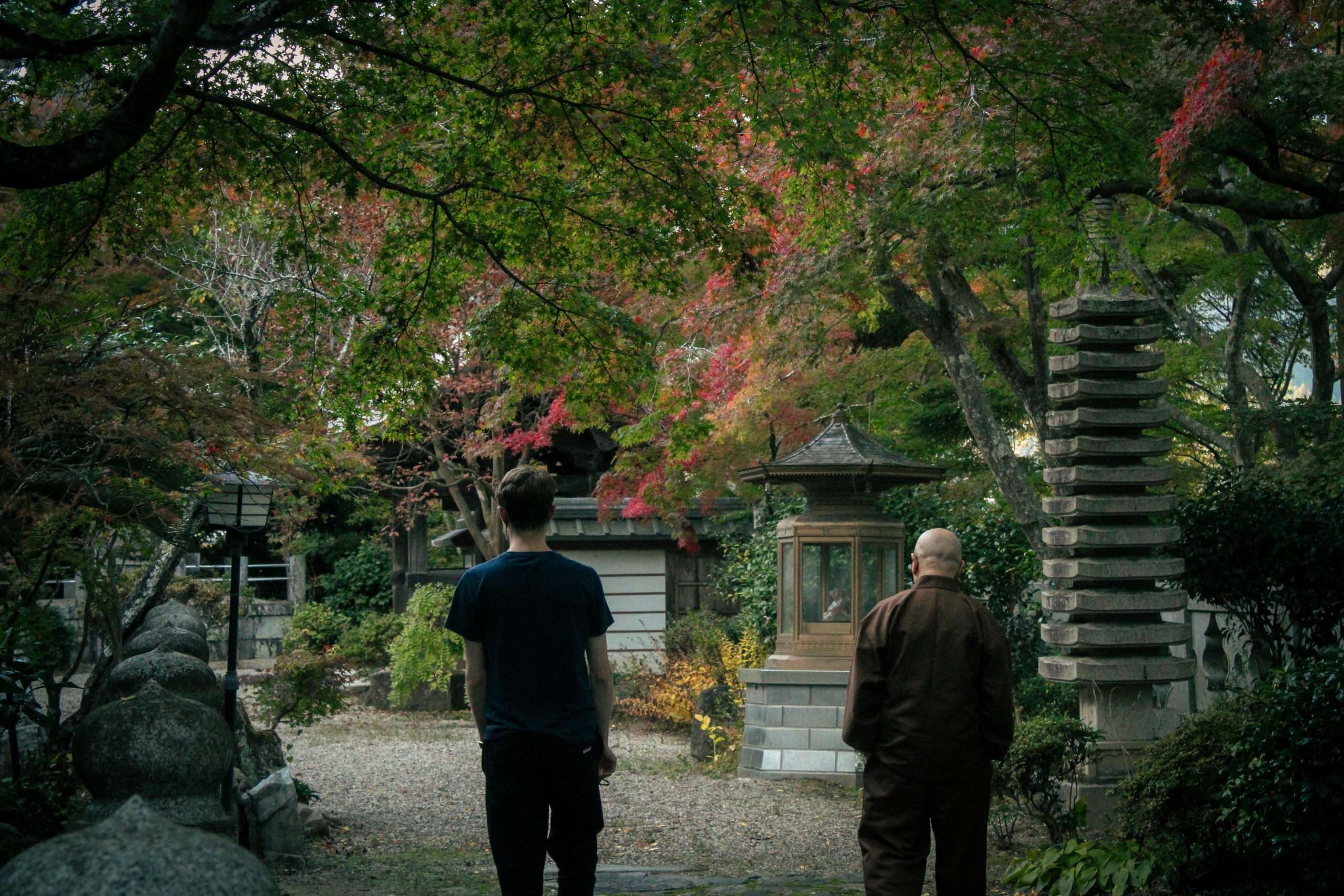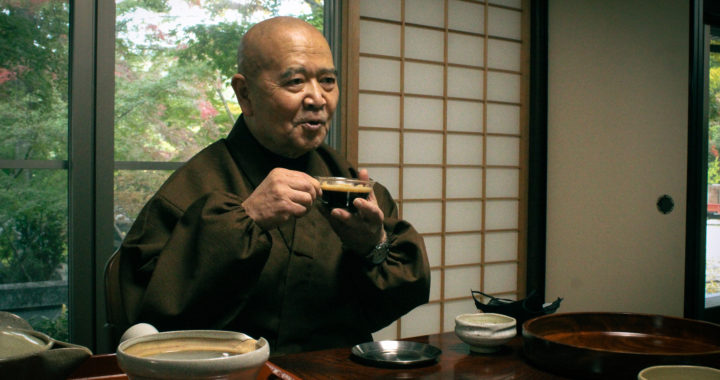Shouhouji is one of Wazuka’s beautiful temples, known for its red fall leaves. Recently, I had the privilege of speaking with its abbot, Tetsudo Ozeki-san. I was able to learn a lot about the deep history between Buddhism and tea. While drinking delicious tea out of teaware that Ozeki-san had made himself, we had this discussion.
All photographs are courtesy of fellow intern Katrina Wild.
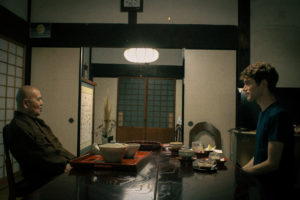
ーWhere is your hometown?
It’s Wazuka.
ーWhat do you think is Wazuka’s attraction?
I’ve always lived here, you know…Everyone comes to visit, so there’s a recognition that it is a good place, but I haven’t actually lived anywhere else.
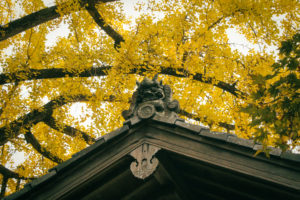
ーWhy did you become a follower of Buddhism?
I was born out of this temple. Europe is monotheistic, but in Japan we have yaorozu [expression for “countless”], many gods and many Buddhas. I grew up in the middle of that, so without any particular doubts, I was born in a temple and remained in a temple as I became an adult.
Japan is a country of yaorozu gods, it’s quite natural to become a monk if you grow up in a temple or to become a priest if you grow up in a shrine. Of course, there are also people who become monks or priests from the outside…but we’re a nation that doesn’t fixate. We are a country that can accept many gods and Buddhas. So, I didn’t have to think so much. I was born and raised in the Zen sect, so I began practicing Rinzai Zen [Rinzai is one of the three largest schools of Zen in Japan]. I didn’t really think about it, you know?
ーTea and Buddhism’s history is so deep. As a person living in a birthplace of Japanese tea, has tea had an influence on your Buddhist practice?
In the Rinzai sect, we begin with tea and end with tea. In Kyoto, Kenninji Temple was where Japanese tea and sadou tea ceremony started. The founder, Yousai [also sometimes written Eisai] brought tea culture from China. In that time, a practice called sarei [tea drinking manners in the Zen tradition] became the basis of sadou [Japanese tea ceremony]. We often offer tea to the Buddha. Every morning, without fail, I offer tea to the Buddha.
Different temples have different relationships to tea. For example, Daitokuji in Kyoto has a deeper history with matcha, so it’s connected to urasenke and omotesenke [the largest schools of matcha tea ceremony in Japan]. Daitokuji even owns a youhentenmoku chawan, which is the highest quality of a tenmoku chawan [a matcha cup glazed with a distinctive ceramic glaze].
The iemoto [heads of a Japanese traditional arts school] of senchado [sencha tea ceremony] are also often from the Obaku school of Buddhism. In the Edo Period, Obaku began sencha culture with reference to tea culture in China. That’s why Manpukuji temple in Uji is a sencha temple.
Because I live in Wazuka, I’ve always been brewing tea. From morning to night, monks in training used to come here and ask for tea.
ーWazuka’s history of Buddhism is also deep, no? Does this town have any particular Buddhist characteristics? Is there a benefit to living here in particular as a Buddhist?
We have every sect represented, hasshuu [eight sects of Buddhism introduced to Japan in the Heian and Nara periods]. If there’s a Pure Land temple, there’s also a Shin temple. Dainenbutsu and so on…many different monks from different sects are around here. In Wazuka alone, there are 24 temples! That’s why, there’s a type of Buddhist enhance. We call ourselves “many sects”. It’s an opportunity to study and mans that we can hear other monk’s stories, so it’s interesting. We all have the same Buddhist attitude towards life…but our families don’t necessarily go the same way. There are monks that even today don’t eat meat or fish…But anyway, there’s interchange between different sects. It’s fun.
For example, pottery isn’t generally considered temple work, but the tea utensils we’re using right now are all pieces I made here. I can’t do it so much anymore, but I used to have the physical strength to make my own pottery.
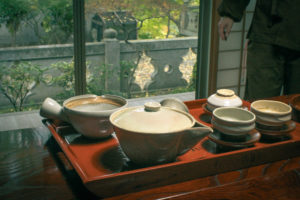
ーThe world is quickly changing. What kinds of changes do you think will come to Japanese Buddhism? What should be preserved?
The supporters of temples and shrines are all getting older! Temples and shrines have a big problem with succession. In other words, I have two sons, but neither will become a monk. They already ran away! They went to university and are having their own careers. Without a doubt, temples and shrines are going to have this kind of problem moving forward.
Of course, Kyoto’s temples (Daitokuji, Nanzenji, Kenninji, Toufukuji, etc.) are head temples. Tourists come to visit. This kind of cultural heritage can’t be lost. So, they will be succeeded. But the other temples don’t really have a future. So, it’s becoming more and more common for monks to become head abbots of two or more temples. I’m currently head abbot for two temples. Indeed, what comes after is going to be difficult.
ーAs a follower of Buddhism, what do you think is an important point to keep in mind?
Maybe due to coronavirus, but the number of areligious people is increasing. Japanese people took in many gods and Buddha’s, but we’re also fast to abandon them!
We in the Zen sect maybe aren’t just a religion, we have a teaching that one should find their own Buddha. So, in Europe we often get called a “philosophy”. If you meet your own Buddha, they satori [enlightenment] can begin. For that purpose, we sit zazen [Zen meditation]. It’s impossible to understand from the path of just thinking with your head. The first thing to do is to sit. There are teachings that cannot be said with words or written with letters. They’re called furyuumonji. That’s closer to philosophy than religion, isn’t it? “Please find it yourself!” we ask.
Europe loves knowledge, doesn’t it? All types of learnings. The kinds of things you can pick up by studying. Rinzai and Zen say, “Sit and catch it yourself! Please practice!” There’s no answer anyway, so I’m at ease but…Please catch it by yourself.
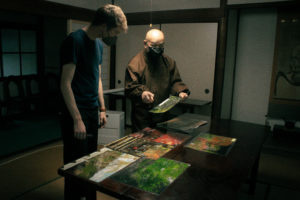
ーThere’s this thing I keep hearing from farmers here, “It’s fine to learn by studying from books, but there is wisdom that comes from experiencing nature.”
Yes, that’s close. “Today it will rain” and such things…you know because you just know.
ーWhat is your favorite tea?
It is bancha. It’s easy to brew in a pot and I don’t feel guilty about my health. But, I also drink black tea and sencha and even coffee. Anything other than alcohol is fine.
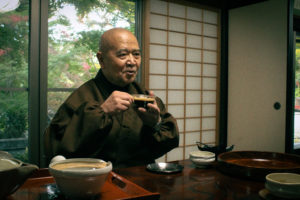
ーWhat do you envision for Wazuka’s future?
I have high hopes for the tunnel. The number of shops has been declining recently because they close. I can’t drive anymore, but I hope that the new tunnel to Uji will have a good impact on the local economy.
